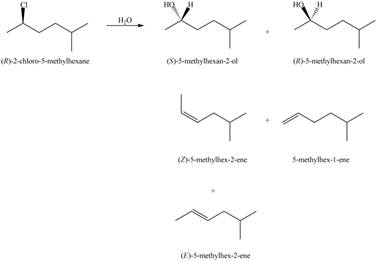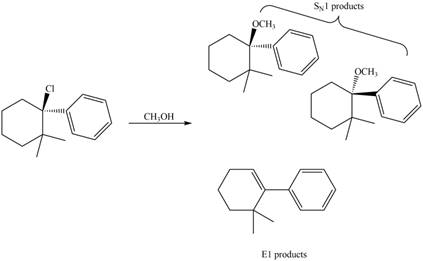
Concept explainers
Draw all products, including stereoisomers, in each reaction.
a. c.
c.
b. d.
d.
(a)
Interpretation: All products formed in the given reaction are to be drawn.
Concept introduction: The one-step bimolecular elimination reaction that favors the removal of a proton by a base from carbon adjacent to the leaving group that results in the formation of a carbocation is termed as
The nucleophilic reaction that consists of bimolecular as well as bond-making and bond-breaking steps is termed as
Stereoisomers have the same molecular formula but they differ in the three-dimensional arrangement of their bonds.
Answer to Problem 8.56P
The products that are formed in the given reaction are
Explanation of Solution
In the given reaction, the secondary alkyl halide is treated with a strong base due to which both substitution and elimination reactions takes place with the given secondary alkyl halide. This reaction results in the formation of three alkenes via

Figure 1
Thus, the products formed in the given reaction are
The products that are formed in the given reaction are
(b)
Interpretation: All products formed in the given reaction are to be drawn.
Concept introduction: The one-step bimolecular elimination reaction that favors the removal of a proton by a base from carbon adjacent to the leaving group that results in the formation of a carbocation is termed as
The nucleophilic reaction that consists of bimolecular as well as bond-making and bond-breaking steps is termed as
Stereoisomers have the same molecular formula but they differ in the three-dimensional arrangement of their bonds.
Answer to Problem 8.56P
The products that are formed in the given reaction are s
Explanation of Solution
In the given reaction, the secondary alkyl halide is treated with a strong base due to which both substitution and elimination reactions takes place with the given secondary alkyl halide. This reaction results in the formation of three alkenes via

Figure 2
Thus, the products formed in the given reaction are s
The products that are formed in the given reaction are s
(c)
Interpretation: All products formed in the given reaction are to be drawn.
Concept introduction: The two-step unimolecular elimination reaction that favors the removal of a HX substituent and the formation of a carbocation intermediate takes place in its first step. In the second step of the reaction, the carbocation forms a double bond. This type of reaction is termed as
The two-step unimolecular reaction which favors the removal of a HX substituent and the formation of a carbocation intermediate takes place in its first step. Then, in the second step, the carbocation undergoes substitution. This type of reaction is termed as
Stereoisomers have the same molecular formula but they differ in the three-dimensional arrangement of their bonds.
Answer to Problem 8.56P
The products that are formed in the given reaction are
Explanation of Solution
The given reaction takes place between the tertiary alkyl halide and methanol that acts as a weak base as well as a weak nucleophile. The given tertiary alkyl halide undergoes elimination reaction via

Figure 3
Thus, the products formed in the given reaction are
The products that are formed in the given reaction are
(d)
Interpretation: All products formed in the given reaction are to be drawn.
Concept introduction: The nucleophilic reaction that consists of bimolecular as well as bond-making and bond-breaking steps is termed as
Stereoisomers have the same molecular formula but they differ in the three-dimensional arrangement of their bonds.
Answer to Problem 8.56P
The product that is formed in the given reaction is shown in Figure 4.
Explanation of Solution
In the given reaction, the secondary alkyl halide is treated with a strong base due to which both substitution and elimination reactions takes place with the given secondary alkyl halide. This reaction results in the formation of three alkenes via

Figure 4
The product that is formed in the given reaction is shown in Figure 4.
Want to see more full solutions like this?
Chapter 8 Solutions
Organic Chemistry
Additional Science Textbook Solutions
Cosmic Perspective Fundamentals
Organic Chemistry
Human Physiology: An Integrated Approach (8th Edition)
Laboratory Experiments in Microbiology (12th Edition) (What's New in Microbiology)
- Write the molecular formula for a compound with the possible elements C, H, N and O that exhibits a molecular ion at M+ = 85.0899. Exact Masses of the Most Abundant Isotope of Selected Elements Isotope Natural abundance (%) Exact mass 1H 99.985 1.008 12C 98.90 12.000 14N 99.63 14.003 160 99.76 15.995 Molecular formula (In the order CHNO, with no subscripts)arrow_forwardUse the data below from an electron impact mass spectrum of a pure compound to deduce its structure. Draw your structure in the drawing window. Data selected from the NIST WebBook, https://webbook.nist.gov/chemistry/ m/z Relative intensity 59 3.0 58 64 43 100 15 23 • You do not have to consider stereochemistry. •You do not have to explicitly draw H atoms. • In cases where there is more than one answer, just draw one. + n[] 85 // ? CH4 Previous Nextarrow_forwardWrite the molecular formula for a compound with the possible elements C, H, N and O that exhibits a molecular ion at M* = 128.0632. Exact Masses of the Most Abundant Isotope of Selected Elements Isotope Natural abundance (%) Exact mass 1H 99.985 12C 98.90 14N 99.63 160 99.76 Molecular formula 1.008 12.000 14.003 15.995 (In the order CHNO, with no subscripts)arrow_forward
- Can I please get help with this? And can I please the lowest possible significant number?arrow_forwardWhat is the molar mass of a gas that takes three times longer to effuse than helium?arrow_forwardFirst image: I have to show the mecanism (with arows and structures) of the reaction at the bottom. Also I have to show by mecanism why the reaction wouldn't work if the alcohol was primary Second image: I have to show the mecanism (with arrows and structures) for the reaction on the left, where the alcohol A is added fast in one portion its not an examarrow_forward
- what is the skeletal structure of a tertiary alkyl fluoride with six carbon atoms and no rings.arrow_forwardOne step of glycolysis is a retro-aldol reaction (aldolase) to produce ATP.Below is the aldol reaction of the equilibrium. Show the mechanism for the base catalyzed reaction. *see imagearrow_forwardProvide the missing information. *see imagearrow_forward
 ChemistryChemistryISBN:9781305957404Author:Steven S. Zumdahl, Susan A. Zumdahl, Donald J. DeCostePublisher:Cengage Learning
ChemistryChemistryISBN:9781305957404Author:Steven S. Zumdahl, Susan A. Zumdahl, Donald J. DeCostePublisher:Cengage Learning ChemistryChemistryISBN:9781259911156Author:Raymond Chang Dr., Jason Overby ProfessorPublisher:McGraw-Hill Education
ChemistryChemistryISBN:9781259911156Author:Raymond Chang Dr., Jason Overby ProfessorPublisher:McGraw-Hill Education Principles of Instrumental AnalysisChemistryISBN:9781305577213Author:Douglas A. Skoog, F. James Holler, Stanley R. CrouchPublisher:Cengage Learning
Principles of Instrumental AnalysisChemistryISBN:9781305577213Author:Douglas A. Skoog, F. James Holler, Stanley R. CrouchPublisher:Cengage Learning Organic ChemistryChemistryISBN:9780078021558Author:Janice Gorzynski Smith Dr.Publisher:McGraw-Hill Education
Organic ChemistryChemistryISBN:9780078021558Author:Janice Gorzynski Smith Dr.Publisher:McGraw-Hill Education Chemistry: Principles and ReactionsChemistryISBN:9781305079373Author:William L. Masterton, Cecile N. HurleyPublisher:Cengage Learning
Chemistry: Principles and ReactionsChemistryISBN:9781305079373Author:William L. Masterton, Cecile N. HurleyPublisher:Cengage Learning Elementary Principles of Chemical Processes, Bind...ChemistryISBN:9781118431221Author:Richard M. Felder, Ronald W. Rousseau, Lisa G. BullardPublisher:WILEY
Elementary Principles of Chemical Processes, Bind...ChemistryISBN:9781118431221Author:Richard M. Felder, Ronald W. Rousseau, Lisa G. BullardPublisher:WILEY





